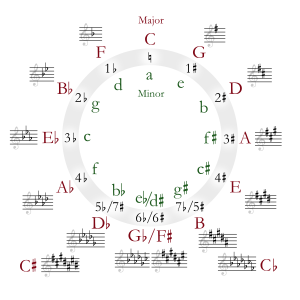| Relative key | D-sharp minor |
|---|---|
| Parallel key | F-sharp minor |
| Dominant key | C-sharp major |
| Subdominant | B major |
| Enharmonic | G-flat major |
| Component pitches | |
| F♯, G♯, A♯, B, C♯, D♯, E♯ | |
F-sharp major is a major scale based on F♯, consisting of the pitches F♯, G♯, A♯, B, C♯, D♯, and E♯. Its key signature has six sharps.
The F-sharp major scale is:
Its relative minor is D-sharp minor (or enharmonically E-flat minor) and its parallel minor is F-sharp minor. Its direct enharmonic, G-flat major, contains six flats in its key signature.
Scale degree chords
The scale degree chords of F-sharp major are:
- Tonic – F-sharp major
- Supertonic – G-sharp minor
- Mediant – A-sharp minor
- Subdominant – B major
- Dominant – C-sharp major
- Submediant – D-sharp minor
- Leading tone – E-sharp diminished
Music in F-sharp major
See also: List of symphonies in F-sharp majorF-sharp major is the key of the minuets in Haydn's "Farewell" Symphony and of the String Quartet No. 5 from his Op. 76, of Beethoven's Piano Sonata No. 24, Op. 78, Verdi's "Va, pensiero" from Nabucco, Mahler's unfinished Tenth Symphony, Korngold's Symphony Op. 40, and Scriabin's Fourth Piano Sonata. The key was the favorite tonality of Olivier Messiaen, who used it throughout his work to express his most exciting or transcendent moods, most notably in the Turangalîla-Symphonie.
Like G-flat major, F-sharp major is rarely used in orchestral music, other than in passing. It is more common in piano music. Some examples include a Nocturne and the Barcarolle by Chopin, the sonatas of Alexander Scriabin and several pieces from Grieg's Lyric Pieces. Shostakovich's String Quartet No. 14 is in this key.
Liszt was apparently fond of F-sharp major, having uplifting while meditative pieces like "Les jeux d'eaux à la villa d'este" from Années de Pèlerinage III, S.163 and "Bénediction de Dieu dans la Solitude" from the set Harmonies Poétiques et Religieuses S.173 in this key. The first polka in Smetana's "3 Polkas de Salon" is in F-sharp major, as is Polonaise No. 1 by Stanisław Moniuszko.
Despite the key rarely being used in orchestral music other than to modulate, it is not entirely uncommon in keyboard music. For orchestration of piano music, some theorists recommend transposing the music to F major or G major. If F-sharp major must be used, one should take care that B♭ wind instruments be notated in A-flat major, rather than G-sharp major (or E♮/B♮ instruments used instead, giving a transposed key of D major/G major).
References
- Frederic Woodman Root (1874). The Song Era: A Book of Instruction and Music for Elementary and Advanced Singing Classes, Choirs, Institutes and Conventions. John Church. p. 9.
External links
 Media related to F-sharp major at Wikimedia Commons
Media related to F-sharp major at Wikimedia Commons
| Diatonic scales and keys | |||||||||||||||||||||||||||||||||||||||||||||||||||||||||||
|---|---|---|---|---|---|---|---|---|---|---|---|---|---|---|---|---|---|---|---|---|---|---|---|---|---|---|---|---|---|---|---|---|---|---|---|---|---|---|---|---|---|---|---|---|---|---|---|---|---|---|---|---|---|---|---|---|---|---|---|
| |||||||||||||||||||||||||||||||||||||||||||||||||||||||||||


